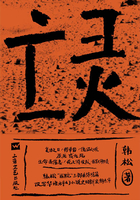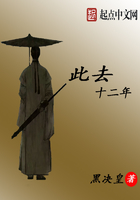The geodesical operation which the commission was about toundertake was trigonometrical;its object was to measure an arc of the meridian.Now to measure one degree,or several degrees,by means of metallic rods placed end to end would be absolutely impossible from the point of view of mathematical exactness.Nowhere,on any point of the globe,could be found a stretch of country sufficiently even for a space of a hundred leagues or more to lend itself to the execution of so delicate an operation.
Fortunately,there is a more rigorous method,by dividing the line which the meridian traverses into so many‘aerial’triangles,whose determination is relatively easy.
These triangles are obtained by sighting,with such instruments of precision as the theodolite,natural or artificial points such as steeples,towers,powerful lights,signal pylons.Each point forms the apex of an angle of one of the triangles,and a good observer can measure the angle very exactly by means of a telescope whose field of view is crossed by a fine thread.In this way there can be obtained triangles whose sides are several miles long.Thus Arago joined the coast of Valencia,in Spain,to the Baleric Islands by means of an immense ******** whose sides measured about 100 miles long.
For,by a principle of geometry any ******** is completely‘known’when one of its sides and two of its angles are known,for the other angle and the length of the two other sides can be calculated at once.So in taking as the base of a new ******** one side of the triangles already formed and measuring the angles adjacent to that base,new triangles can be obtained,and these can be successively extended to the end of the arc to be measured.So too there can be ascertained the length of the straight lines within the network of triangles and even that of the arc of the meridian which traverses the whole network.But the first side—the base of the whole system—must be measured on the ground with the greatest possible accuracy,and this is the most delicate part of the whole operation.
When Delambre and Mechain measured the meridian of France from Dunkirk to Barcelona they took for the base of the triangulation a rectilineal direction on the road from Melun to Lieusaint in the Seine-et-Marne.This base was 12,150 metres in length,and it took no less than forty-five days to measure it.The methods used by these savants to obtain mathematical accuracy were the same as those of Colonel Everest and Matthew Strux.It will be seen to what point accuracy could be carried.
The beginning was made on the 5th March,to the great surprise of the natives,who could not understand it.To measure the ground with six-foot rules placed end to end seemed to the hunter a joke on the part of the savants.But he had done his duty.They had asked for a broad level plain,and he had found one.
The situation was very well chosen for the direct measurement of a base.The plain,covered with a dry short grass,extended as far as the limit of the horizon on a perfect level.Certainly the operators on the Melun road had not been as well favoured.Behind was the undulating line of hills which formed the extreme southern limit of the Kalahari desert;northward infinity;eastward the slopes of the hills which formed the table-land above Lattakou died gradually away in the distance.
Westward the ground sank lower,and became marshy,as it absorbed the stagnant water which fed the affluents of the Kuruman.
‘I think,Colonel Everest,’Matthew Strux glanced,after looking at the even extent of grass before him—‘I think when our base is established we can fix the terminal point of the meridian here.’
‘I am quite of your opinion,Mr.Strux,’agreed Colonel Everest,as soon as we have settled the exact longitude of that point.We must first make sure by referring to the map that this arc of the meridian will not meet with any insurmountable obstacles which might bring our operations to a stop.’
‘I don’t think it will,’replied the Russian astronomer.
‘We’ll see,’said the English astronomer;‘let’s first measure the base at this point,as it’s so favourable,and then we’ll decide if it will be convenient to unite it by a series of auxiliary triangles which will have to traverse the arc of the meridian.’
This settled,they decided to proceed to measure the base without delay.The operation would necessarily take long,for the members of the commission meant to carry it out with rigorous exactitude.It was a question of surpassing the accuracy of the measurements made in France on the Melun base,measurements so perfect that a new base measured later at Perpignan,at the southern end of the triangulation,and intended to verify the calculations,showed a difference of only eleven inches in a distance of three hundred and thirty thousand fathoms between the measurement directly obtained and that calculated.
Orders to camp were accordingly given,and a sort of Boschjesman village or kraal was improvised on the plain.The waggons were arranged like houses,and the hamlet was divided into the Russian and the English quarter,with the respective national ensigns flying above them.In the centre was a communal space.Outside the waggon line the horses and oxen were tethered,guarded by their drivers,and at night they were brought inside the enclosure to protect them from the rapacity of the beasts of prey which abound in the interior of Africa.
Mokoum was entrusted with the food supply of the village,and Sir John Murray,whose presence was not indispensable for measuring the base,occupied himself with the commissariat.
Thanks to the skill of Mokoum and his companion,there was no want of game.The plains and hills were beaten for several miles round the camp and the report of a rifle was repeatedly heard throughout the day.
On 6th March they began their operations.The two younger members of the commission were entrusted with the preliminary work.
‘Come along,comrade,’Michel Zorn was gaily addressing William Emery,‘and may the God of accuracy help us.’
The first operation consisted in tracing a straight line on the ground where it was flattest and stretched furthest.Here the slope of the ground orientated it from south-east to north-west.Its perfect straightness was obtained by means of stakes driven into the ground a short distance apart to serve as‘sights.’Michel Zorn,using a telescope provided with crosshairs,verified their position and declared it exact when the cross-hair divided all their focal images into two equal halves.
This straight line was continued about nine miles,the length which the astronomers hoped to give to their base.Each stake was topped by a sight which would facilitate the setting out of the metallic rules.The work demanded several days and the two young fellows accomplished it with scrupulous exactitude.
It was now a question of placing end to end the measuring rods meant to carry out the direct measurement of the base of the first ********,an operation which might seem perfectly ****** but which actually demanded infinite care,for upon it largely depended the success of the triangulation.
During the morning of 10th March,wooden sockets were set in the ground,following the straight line already marked out.These sockets,twelve in all,each rested on three iron spikes,which kept them in place and prevented them from moving in any way.On these sockets were placed small pieces of wood,perfectly shaped and accurately adjusted to support the rods and hold them in small clamps.These fixed their direction without interfering with their expansion,which would vary with the temperature,and which had to be taken into account.
When the twelve sockets were fixed and the pieces of wood adjusted,Colonel Everest and Matthew Strux undertook the delicate task of laying the rods,the young men also assisting.Nicolas Palander,pencil in hand,stood ready to set down in a duplicate register the figures dictated to him.
Six measuring-rods were used,and their length had been accurately measured beforehand with absolute precision.They had been checked with the old French toise(fathom)generally used in geodesic work.
The rods were two toises(six feet)long,half an inch wide,and a twelfth of an inch thick.The metal used in their construction was platinum,a metal unaffected by the air in normal circumstances,and oxydised neither by cold nor heat.
The platinum rods,however,could undergo an alteration of length under the variable action of the temperature.So each had been provided with its own‘thermometer’—a metallic thermometer based on the principle that the different metals are differently affected by the action of heat.Each was accordingly covered with another,somewhat shorter,copper rod.
A vernier placed at the end of the copper rod showed very exactly the relative alteration in its length,and from this could be deduced the absolute alteration in that of the platinum.The vernier was moreover provided with a microscope which showed the most minute changes.
These rods were laid on the pieces of wood,end to end without touching,for it was essential to avoid the shock,however slight it might be,which would have resulted from their contact.
Colonel Everest and Matthew Strux arranged the first rod so that it pointed in the direction of the base.A hundred fathoms away a sight had been placed on one of the stakes,and as the rods were provided with two upright iron points placed exactly in its axis,it was easy to direct them exactly precisely in the desired direction.Emery and Zorn had stayed behind,and,crouching down on the ground,made certain that the two points were aligned with the centre of the sight.This enabled the correct direction of the rod to be made certain of.
‘Now’said Colonel Everest‘we’ve got to find out the exact starting-point of our operation,by hanging a plumb-line from the end of the first rod.There’s no mountain here to have any perceptible action on the line,and so it will indicate on the ground the exact position of our base.’
‘Yes’replied Matthew Strux‘but only so long as we take into account the half-thickness of the line at the point of contact.’
‘I quite realise that’retorted Colonel Everest.
The starting-point located exactly,work continued.But it was not enough for the rod to be aligned along the base.Allowance had to be made for its inclination with the horizon.
‘We don’t mean,I suppose,’asked Colonel Everest,‘to place this rule exactly in a horizontal position?’
‘No’replied Matthew Strux‘it will be enough to compare the angle which each rule makes with the horizon,and then we can reduce the length we measure to the true length.’
The two savants being agreed,the operation was carried out by means of a specially-made level,consisting of a movable alidade centred on a joint at the top of a wooden square.A vernier measured any inclination by comparison of its divisions with those of an arc measuring ten degrees divided into five-minute intervals.
The level was compared with the measuring-rod and the difference read off.But as Nicolas Palander was about to enter it in his register after it had been agreed by the two savants,Matthew Strux suggested that the level should be turned round to ascertain the difference between the two arcs.This difference would be double the slope,thus checking the accuracy of the work.After that his advice was followed in all future operations of this kind.
These results,with those of the calculations made by Nicolas Palander,were duly entered down and initialled.
It was now necessary to place the second rod on the wood in line with the first rod,but leaving a small interval between them;again its iron points were aligned exactly on the centre of the sight.
The interval between the two rods had next to be measured.At the end of the first,where it was not covered by the copper rod,was a small platinum tongue which slid with hardly any friction between two slides.Colonel Everest gently slid it forward until it just touched the second rod.Then a vernier,fitted with a microscope,enabled the interval between the two rods to be found with mathematical accuracy.
Meanwhile,to keep the rods from lengthening under the influence of the sunshine,they had to be sheltered under a roof,high enough above the ground not to hinder the operations.
These tasks were continued with patience and minute attention to detail for more than a month.When the four rods had been placed in position and measured,the work was carried on with the same regularity by taking the first rod,with all its accessories,beyond the fourth,and it took much time in spite of the skill of the operators.All they could measure was about two hundred and twenty fathoms a day,and sometimes,even during good weather,they had to suspend the operations because the wind was so strong it threatened the stability of the apparatus.
Every evening,about three-quarters of an hour before the failing light made it impossible to read the verniers,the savants suspended the work and took suitable precautions to enable it to be continued next day.The exact position of the end of the rod was marked on a lead plaque mounted on a wooden stake driven into the bottom of a small hole made in the ground;the plaque was protected by a wooden shield,and the stake buried till next day by filling in the hole.Thus if any accident disturbed any of the apparatus during the night,it would not be necessary to repeat the entire operation.
Next day the plaque was uncovered and the rod replaced in its former position by means of the plumb-line,whose point had to fall exactly on the mark made on the plaque.
This series of operations was continued for thirty-eight days on this plain,which,fortunately for the work,was so level.All the results were recorded in duplicate,verified,collated,and agreed by all the members of the Commission.
Few discussions had so far arisen between the Colonel and his Russian colleague.Certain figures taken from the vernier and referring to the four hundred millionths of a fathom had occasionally given rise to an exchange of tart comments,but on the majority being appealed to,its opinion was decisive,and they had to give way before it.
One question alone gave rise to such an exchange of words,more than hasty,between the two rivals that Sir John Murray was obliged to interfere.It was the question as to the length which should be given to the base of the first ********.It was undisputed that the longer the base the easier the angle forming the apex of the first ******** would be to measure,because it would be so much more obtuse;still there must be some limit to its length.Colonel Everest proposed a base of six thousand fathoms,nearly equal to that measured directly on the Melan road.Matthew Strux wanted the base extended to ten thousand fathoms,as the nature of the ground was so favourable.On this question Colonel Everest was intransigent;Matthew Strux was equally determined not to give way.From argument they soon came to personalities,and the question of nationality threatened to arise at any moment.They were no longer two savants,they were an Englishman and a Russian face to face.Fortunately this debate was cut short by bad weather,which lasted several days;the disputants grew calmer and the majority decided that the measure of the base should be fixed at eight thousand fathoms,thus splitting the difference.
In short,the operation was successfully carried out,and with the greatest accuracy.It was to be mathematically tested later measuring a new base at the northern end of the meridian.The exact direct measurement of the original base was 8037.75 fathoms,and on this was to be constructed the series of triangles which was to cover South Africa for a space of several degrees.















